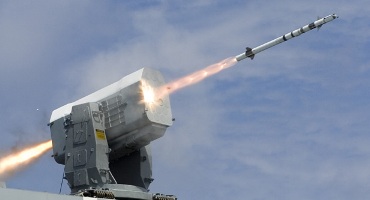
The Rolling Airframe Missile. A Raytheon photo
NEW YORK (BNS): The new block 2 Rolling Airframe Missile (RAM) has achieved initial operational capability (IOC) after undergoing a series of tests between May 2013 and March 2015.
The US Navy announced IOC for the weapon -- a cooperative programme between the US and German governments -- aboard the amphibious transport dock ship USS Arlington (LPD 24) on 15th May.
The new RAM block 2 missile is designed to counter advanced anti-ship cruise missile threats that the US and allied navies face today.
"We're very excited about the significantly increased capability Block 2 gives our warfighters. It could not have been done without the outstanding cooperation between the US and German governments," said Capt. Craig Bowden, RAM programme manager.
Compared to previous configurations, the RAM Block 2 provides significantly improved kinematic performance in manoeuvrability and range as well as a more sophisticated radio frequency receiver.
These improvements allow RAM to increase the battlespace and engage low probability of intercept threats at longer ranges, the Navy said in a statement.
Prior to the IOC declaration, the US Navy and German government successfully demonstrated the enhanced ship self-defence effectiveness of the Block 2 RAM during testing at the Pacific Missile Range Centre at Point Mugu, California, between May 2013 and March 2015, it said.
Currently, the dual-mode, supersonic, fire-and-forget RAM is deployed on board the US Navy's CVN, LCS, LHA, LHD, LSD and LPD 17 class warships and twenty-two of German Navy warships. The weapon is designed to function as part of a layered ship defence system by working in tandem with other missile defence systems.
 Previous Article
Previous Article Next Article
Next Article













The Indian Air Force, in its flight trials evaluation report submitted before the Defence Ministry l..
view articleAn insight into the Medium Multi-Role Combat Aircraft competition...
view articleSky enthusiasts can now spot the International Space Station (ISS) commanded by Indian-American astr..
view article